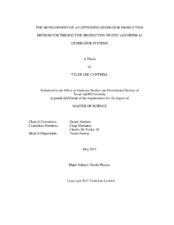| dc.contributor.advisor | Akabani, Gamal | |
| dc.creator | Cantrell, Tyler Lee | |
| dc.date.accessioned | 2015-09-21T17:02:12Z | |
| dc.date.available | 2017-05-01T05:35:56Z | |
| dc.date.created | 2015-05 | |
| dc.date.issued | 2015-05-06 | |
| dc.date.submitted | May 2015 | |
| dc.identifier.uri | https://hdl.handle.net/1969.1/155169 | |
| dc.description.abstract | The demand for radionuclides used in positron emission tomography (PET) must be met if the role for PET in Nuclear Medicine is to be expanded. The best method for supplying PET radionuclides to satellite PET facilities is through the use of radionuclide generators. The generator of interest in this study was the 62Zn/62Cu generator system. The objective of this study was to optimize the methods for producing 62Zn/62Cu so that they may be better suited for routine production. This involved examination of the bombardment parameters and the procedure utilized to dissolve the irradiated copper target. Additionally, the feasibility in automating the different processes of the production methods through a modular system was examined to aid in streamlining the routine production of the generator systems.
The analysis showed that, between proton entry energies of 18 and 30 MeV, a target thickness of 1.0 mm was optimal for producing 62Zn. With a 1.0 mm thick target, the optimal proton entry energy for maximizing the production yield of 62Zn was 29 MeV. The theoretical 62Zn yield at 29 MeV directly prior to generator loading was calculated to be between 160 and 180 GBq·μA-1·h-1. An alternative target processing method based on 30% hydrogen peroxide (H2O2) and 2 M hydrochloric acid (HCl) at a temperature of 75 °C successfully dissolved the copper foil within 12 minutes. The color of the solution indicated that the copper (II) ions formed the hexaaquacopper(II) ion in 2 M HCl used for chemical separation. Finally, devices were purchased for automating the generator production process, including heating and transfer of solutions, and electronic manipulation of valves. These devices were controlled using the software LabVIEW which demonstrated the feasibility of building a system capable of automating the production of this generator system. A detailed overview was provided on how to control these instruments with LabVIEW. | en |
| dc.format.mimetype | application/pdf | |
| dc.language.iso | en | |
| dc.subject | generator | en |
| dc.subject | PET | en |
| dc.subject | positron emission tomography | en |
| dc.subject | zinc-62 | en |
| dc.subject | copper-62 | en |
| dc.subject | generator production | en |
| dc.title | The Development of an Optimized Generator Production Method for the Routine Production of Zinc-62/Copper-62 Generator Systems | en |
| dc.type | Thesis | en |
| thesis.degree.department | Nuclear Engineering | en |
| thesis.degree.discipline | Health Physics | en |
| thesis.degree.grantor | Texas A & M University | en |
| thesis.degree.name | Master of Science | en |
| thesis.degree.level | Masters | en |
| dc.contributor.committeeMember | Marianno, Craig | |
| dc.contributor.committeeMember | Folden, Charles M | |
| dc.type.material | text | en |
| dc.date.updated | 2015-09-21T17:02:12Z | |
| local.embargo.terms | 2017-05-01 | |
| local.etdauthor.orcid | 0000-0002-9254-9767 | |


